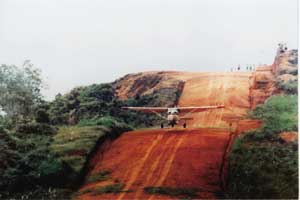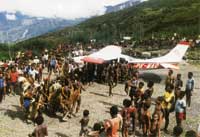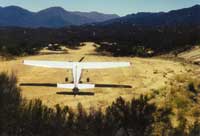|
|

| Bush Flying at Its Pinnacle |
| Mission Aviation Fellowship |

|
By Michael Magnell
Who operates the largest humanitarian airline in the world? If you said Mission Aviation Fellowship, you’re right on.
Which airline flies into some of the most extreme airstrips located in the most isolated places on earth? If you said Mission Aviation Fellowship, you’re right again.
Headquartered in Redlands, California, Mission Aviation Fellowship (MAF) aircraft, pilots, and crews have been quietly heeding the call to serve others for over 50 years.
In the midst of W.W.II, the seeds were planted for what was to become the international ministry of MAF. While listening to the harrowing travel experiences of a missionary serving in Borneo, a small group of W.W.II Christian pilots realized that they could go, with relative ease, where missionaries could seldom venture. In 1945, MAF was born. In 1946, MAF’s first field pilot, Betty Greene, flew a 1933 Waco Biplane down to Mexico to support Wycliff bible translators. Today, 200 MAF families fly 75 aircraft at 34 bases in 18 countries, annually making 80,000 flights totaling 5 million miles and landing at some 3,000 dirt or grass strips — more than any major world airline.
These flights support Christian workers, evangelists, and teachers; deliver food, seed, and livestock; transport sick and injured villagers; ferry doctors, medicine, and relief supplies; and, in general, carry the materials for a better life to people who need it the worst in some of the planet’s most inaccessible areas.
The MAF fleet consists of Cessna 185’s, Cessna 206’s, a Cessna 172, Cessna 207’s, Cessna 208’s, Cessna 210’s, Cessna 402’s, a King Air 200, and a Hughes 500C helicopter. Several of the Cessna 185’s and Cessna 206’s are operated on floats. This fleet is used to support the activities of over 500 Christian and humanitarian groups worldwide.
 According to Paul Lay, a MAF pilot in Indonesia from 1982-88, “Being a MAF pilot is flying on the frontlines of a war against isolation, poverty and darkness: it’s giving people — men, women and children — who have no chance, a second chance. MAF pilots don’t pull down the pay of a lot of professional pilots, but they’re the richest flyers I know.” According to Paul Lay, a MAF pilot in Indonesia from 1982-88, “Being a MAF pilot is flying on the frontlines of a war against isolation, poverty and darkness: it’s giving people — men, women and children — who have no chance, a second chance. MAF pilots don’t pull down the pay of a lot of professional pilots, but they’re the richest flyers I know.”
MAF pilot Paul Bergen states what it’s like to fly the bush in Indonesia: “You take off from your departure point, and then fly for 1 1/2 hours over nothing but jungle. Once there, you land on a postage stamp-sized airstrip with maybe a 15 percent grade. A steep hill stateside might have a 6 percent grade for your car to climb. Can you imagine even landing on that? What’s more, you often have to negotiate tricky air currents and short, even slippery strips of less than 2,000’ length. On top of that, these grass or earth strips may or may not be populated by livestock or anxious villagers. That’s what it’s like to fly over there.”
The everyday flying that MAF pilots do day-in and day-out is probably borderline stunt flying for the average non-commercial general aviation pilot. This is exactly the kind of flying many young people dream about, and for most, it remains an elusive dream. It could be said that these MAF pilots are living a dream, both as airmen and as dedicated humanitarians.
MAF president Gary Bishop sums up the motivation of his organization best in a letter written in spring, 1999. He writes, “Why do we do it? Because we must. Jesus said, ‘Therefore go and make disciples of all nations, baptizing them…teaching them…’ because He said we are to care for the sick, hungry, imprisoned and needy.” Since the most needy are so often beyond the reach of conventional transportation, MAF aircraft are the critical link.
Keeping MAF planes flying safely and reliably has eternal consequences. I got a glimpse of what flying for MAF is really like from talking to Paul Bergen, MAF’s Manager of Flight and Maintenance, at the MAF headquarters in Redlands.
Paul began by telling me the backbone of their fleet is the Cessna 206 and Cessna 185. The 185’s are being slowly phased-out in favor of the 206, as MAF airstrips gradually improve. Having one type of plane is best for commonality in maintenance and flight training. The 206, with its big double doors and voluminous interior, is much better for carrying loads. Right now, there is only one strip in the MAF system that definitely requires the more versatile tailwheel 185.
A typical MAF airfield is primitively hand-carved from the jungle, surrounded by mountains (actually, it often is part of the mountain), and, most often, wears a copious slope. Much of the time these strips aren’t even straight. All flying is preferably complete before noon, since afternoon thunderstorms and wind conditions make operating on these marginal strips too risky. On one particularly hazardous strip in MAF’s system, all flying is halted by 9:30 a.m. for these same reasons.
 How does MAF prepare a pilot to fly in such conditions? Paul said it takes 35 to 45 hours of training, and starts out of Redlands, California, flying in the San Bernadino Mountains. “We have a set of standard operating procedures (SOP), just like any large airline,” he said. How does MAF prepare a pilot to fly in such conditions? Paul said it takes 35 to 45 hours of training, and starts out of Redlands, California, flying in the San Bernadino Mountains. “We have a set of standard operating procedures (SOP), just like any large airline,” he said.
One interesting maneuver MAF instructors teach is the emergency 180-degree turn in a box canyon. They start up one side of a canyon at 80 knots and 20-degree flaps. The turn is executed at 80 knots with full power and full flaps at 60-degrees of bank. Paul says the plane will turn on a dime configured in this manner.
Other things taught are package drops, tying loads down in a manner to accept a 10G deceleration, runway evaluations (which require a minimum of three passes), and operations from runways with extreme grades. Most of these strips have no go-around capability once on final approach and dirty. The landing is always uphill and the take-off downhill. Paul assured me the first time any pilot attempts an uphill landing on a significant slope the pilot will invariably flare too high and drop in for a hard landing. MAF trains on several private strips with slopes in southern California. But there’s really nothing radical enough to meet the challenge of their needs. Therefore, three times a year MAF trainers proceed north to Idaho, where several airstrips exist with a difficulty factor high enough for pilot training to be completed.
The minimum requirements to be considered as a MAF fixed-wing pilot are as follows: a commercial license with instrument rating and 400 hours, 50 hours of high performance time, and an airframe and powerplant mechanics license. Recommended requirements include holding a certified flight instructor rating and tailwheel aircraft experience.
MAF adds Horton STOL kits and flint tip tanks as SOP to their Cessna 206’s. The flint tanks increase gross weight by 200 lbs., and decrease speed on final approach by 5 to 7 knots. These tanks are their most favored modification. Another MAF trademark is all of their aircraft sport brightly painted red wingtips, for search and rescue reasons. When it comes time for a new engine, factory remans have proven to be the best way to go. MAF has tried many different overhaul shops, and none have held up as well as a factory remanufactured motor.
Paul Bergen has been a MAF team member for 20 years. The first five of those, he spent with his wife in Indonesia, where he flew and maintained a MAF C-185. Today, he finds himself back in those same Indonesian villages a couple times each year, giving check-rides to MAF pilots. The local natives are always happy to see him again. On one trip a local villager literally gave him a complete planeload of flowers and said, “Take these to your wife.” Paul says MAF does a lot of rewarding things. All for no profit, and performed solely through donations.
|
|
For more information contact the Mission Aviation Fellowship, P.O. Box 3202, Redlands, CA, 92373-0998, or call (909) 794-1151, or visit www.maf.org.
|
Click here to return to the beginning of this article.  |
|